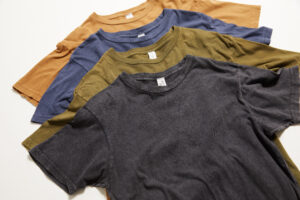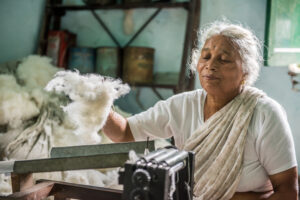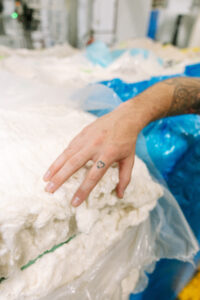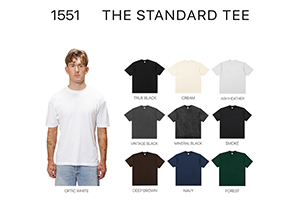We all love them. We all own way too many of them. You know what I’m talking about: the T-shirt! Now, some people may think of a T-shirt as a very simple thing, but more always meets the eye when it comes to everyone’s favorite go-to apparel. T-shirt craftsmanship involves far more complexity than consumers, and even some decorators, might imagine. The manufacturing process behind a seemingly simple garment is meticulous, requiring deep industry knowledge, innovative techniques and careful attention to detail. Well-renowned experts from leading apparel brands across the industry explain how each step—from initial concept through production and decoration—is essential in crafting high-quality, consumer-friendly sustainable tees.
Concept and Design
The journey to the perfect T-shirt begins long before it reaches retail shelves and wholesale warehouses. It’s a science all beginning with an idea, trend research and analysis.

Getting the right garment into the hands of the end user is one of the most important sales tools you have. Photos courtesy of Lane Seven
“The products that you see listed in the store or online as new likely began their development process anywhere from nine to 24 months prior,” says Marcus Davis, product manager at Hanesbrands Inc. “The idea typically starts with a team identifying a target market and a price point.”
Adding further depth to this phase, Milissa Gibson, director of sales at Lane Seven Apparel, says the design process can be as easy or complicated as you want to make it, but it will all come down to finding the ideal niche for a specific market. Echoing Davis, Gibson says “It always starts with an idea or concept, like a mood board, often taking elements from one design and combining it with another.”
This can then help determine what fabrics will be considered, where the product will be made, and what features and benefits should be included. Once those details have been narrowed, then a team will work on designing what the tee will look like, create patterns and begin fabric development for prototype samples.
“The first step in a new style is design,” says Jakob Daito, president and co-founder of US Standard Apparel. “A mood board is created to inspire a direction, oftentimes based on vintage references. Once the idea takes form, the concept is passed to the tech and pattern team who digitizes the pattern. This pattern is then shared with the sample department to cut and sew the initial samples for fitting.”
It’s all about what the consumer wants at a specific time, so research is fundamental explains Jen Oleksik, vice president of apparel of Live & Tell Apparel by L.A.T. “Looking at fabrics, fits, details and decoration trends are all key factors in building out a T-shirt before you even begin designing. From there, it’s landing on a fabric, making sure your T-shirt specs are the perfect fit, and in our industry, making sure it’s easy to decorate across various techniques.”
Fabric Selection
Choosing the right fabric is crucial. Whether the fabric type is created in-house or sourced across third-party suppliers, it must measure up to the aforementioned qualities. Otherwise, the final product will be futile setting the process back not only in time but money as well.

The T-shirt process starts with fiber selection. Whether it’s organic cotton, recycled polyester or a performance blend impacts durability, comfort and sustainability. Photo courtesy of TO THE MARKET
“Fiber selection impacts durability, comfort, and sustainability,” says Mehathab Joharullah, TO THE MARKET’s compliance and impact analyst. “Fibers are spun into yarn, which is knit into fabric [jersey being the most common for T-shirts]. After knitting, the fabric undergoes pre-treatment processes, like dyeing, softening and sometimes enzyme washing for a soft, worn-in hand feel.”
Mel Lay, co-founder of Allmade Apparel, elaborates, “Once the yarn is ready, the next step is to weave or knit the fabric. In the case of Allmade Apparel, we focus on creating a fabric that’s soft, durable and breathable, perfect for everyday wear or custom decoration.”
Oleksik notes that consumer preferences must also be taken into account during fabric selection, noting, “Higher quality, combed ring-spun cotton garments can look and feel better and ultimately decorate nicer.”
Fabric weight, measured in grams per square meter (GSM), can determine durability, weight and feel, says Joharullah. “Lighter weights (120-150 GSM) are airy and ideal for layering, but can be sheer and have lower tear strength. Midweight fabrics (160-180 GSM) offer the best balance of comfort and structure, making them the industry favorite, while heavyweights (200+ GSM) provide extra durability, more structure and warmth—ideal for long sleeves, lightweight sweatshirts or rugby style polos, for example.”
Garment Construction
Textile manufacturers employ different types of equipment to knit the selected fabrics for T-shirts, with certain machines being more prevalent in either the Eastern or Western hemisphere. The type of equipment used usually depends on the preferred construction method. There are two primary construction methods: tubular and side-seamed.
“Tubular tees, or tees without any seams on the side of the body, are made from machines that knit the fabric in a tube, much like a sock,” explains Davis. “The size of the tee is determined by how wide the tube of fabric is knit. Other machines can knit fabrics in a single-ply sheet, which is known as an open width fabric. Because the fabric is knit single-ply, the tee made from this fabric will end up with seams where the body was assembled. Side-seamed garments can be made from tubular knit fabrics that have been cut, but you can’t make a tubular tee from open width fabric.”
Gibson points out the economic advantage of tubular garments, which are knit in a continuous tube, but also mentions, “Side-seam shirts lead to a much more elevated fit and overall product.”

The relaxed, lived-in look and feel of the Ladies Vintage Wash Tee never goes out of style. Photo courtesy of LAT Apparel
The key benefit to a tubular garment versus a “regular” or side-seamed tee, would be a lower cost, Oleksik agrees. “However, the benefits of a side-seamed tee are more in quality and performance. Side seams aid in a better fit and less torque when washing.”
Utilizing side-seam construction will significantly enhance the wearability of a T-shirt, providing a more tailored fit that better aligns with all body types, while reducing twisting and distortion after washing.
“Side-seamed T-shirts offer better fit and reduce fabric waste, despite higher costs,” Joharullah says. “Once prepared, the fabric is cut into pieces like a puzzle according to the design specifications for the perfect fit, stitched together using specialized sewing techniques, and finished with details like ribbed necklines, reinforced seams, or double-stitched hems for the best quality possible.”
Lay also supports side-seamed construction for its quality advantages: “We love for our products to be categorized into the fashion-fit category, offering a more flattering silhouette.”
Attention to Detail
In addition to fabric consistency, quality T-shirt production hinges on precise stitching and finishing. According to Oleksik, higher-quality garments typically feature “double-needle stitching or cover stitches, enhancing durability.”

From the beginning, precision is paramount. Photo courtesy of Hanesbrands
When evaluating the quality of a T-shirt, Davis suggests one of the first things you should be on the lookout for is noticeable puckering and/or waviness around the seams. This is typically the result of too much or not enough tension on the fabric when sewing. “Another easy thing to identify is whether there are any broken or popped stitches,” he says. “This could result in seams coming apart after washing and wearing.”
Gibson emphasizes how much details matter. “Look at sewing hems—extra fabric, loose threads, single or double-needle stitches—these indicate the garment’s quality.”
For its part, Allmade uses reinforced stitching in critical areas like the shoulder and arm seams to prevent unraveling over time, further evidence of the importance of this aspect of T-shirt production.
“We sew using tee manufacturing, where each operator constructs a single portion of the garment in rapid succession,” says Marty Bailey, US Standard Apparel president of manufacturing. “The components are moved through the line until the finished garment takes form, a QC at the end of each line triple checks for any defects or issues.”
Once construction is complete, it is vital each T-shirt undergoes quality control checks before being pressed, folded and packaged for distribution. Joharullah explains that each step requires precision—especially when balancing softness, strength and sustainability.
Sustainability Practices
Sustainability remains a critical aspect of modern apparel production. There is a growing global demand for sustainable manufacturing practices that stress environmental responsibility at every stage—beginning at the seed level. This shift reflects a more conscious consumer base and stricter

Allmade prioritizes eco-friendly materials above all. Photo courtesy of Allmade
regulatory landscapes. Europe is at the forefront of this movement, setting standards that drive the market through both legislative requirements and strong consumer preferences for ethically produced, eco-friendly apparel. However, U.S. manufacturers have now made sustainability a priority as well.
Describing HanesBrands’ sustainability efforts, for example, Davis says, “75 percent of [HanesBrands’] cotton is grown in the U.S. by farmers using leading environmental practices. Nearly 59 percent of our electricity comes from renewable sources, and we’re committed to reducing packaging waste significantly by 2025.”
Similarly, at Allmade sustainability is central to the company’s fabric choices, which include fabrics made from materials like organic cotton, recycled polyester and modal. “Allmade’s dedication to sustainability is to continuously prioritize eco-friendly materials and eco-conscious manufacturing processes, minimizing waste, using water-based inks and reducing carbon emissions,” Lay says.
Joharullah stresses that true sustainability extends beyond fabric: “Sustainable materials are just the baseline. True sustainability examines the manufacturing process itself—energy and water usage, waste monitoring, carbon reduction, and ethical labor practices.”
One thing is clear, manufacturers worldwide are being challenged—and incentivized—to reimagine their production models to meet these fast-evolving expectations.

Selected materials are spun into yarn, which creates the foundation of the fabric. Photo courtesy of Allmade
“At Live and Tell Apparel, we have a sustainability team that works to ensure we are making a conscious effort to not only improve sustainability in our manufacturing, but also in our daily operations,” Oleksik says. “Our sustainable products such as the 6901ECO tee blends 60-percent organic cotton and 40-percent recycled polyester. We are also currently implementing some new processes that will greatly reduce our sampling needs while improving our speed to market.”
“You are seeing major advancements in regenerated and recycled materials and costs coming down; sometimes it’s even less expensive for products [like our LS18002 Future Fleece made from 100-percent regenerated yarn] to be made from either regenerated or recycled materials than a standard garment,” says Gibson.
“A truly sustainable T-shirt isn’t only about what it’s made from—it’s about how it’s made,” says Joharullah.
Decoration and Compatibility
Fabric choice, construction and sustainability are not the only factors manufacturers consider during the production process. Apparel decorators and the challenges they often face are also at the very forefront of T-shirt design, a surprisingly complex problem Davis acknowledges the industry is still working to master. “It’s difficult to create one perfect T-shirt for all decorating methods. Direct-to-film (DTF) printing helps solve compatibility issues, but fabric content still significantly impacts decoration.”
Oleksik notes there can also be limitations with textured fabrics. Lower quality fabrics can pill or shed as well, further complicating decoration. She says to stay vigilant as thorough testing during the development process can prevent these issues.
Addressing decoration-specific difficulties, Gibson says certain printing techniques like sublimation or direct-to-garment (DTG) require specific fabric compositions, but advancements in print technology have expanded compatibility.

Tees with the least amount of sewing are the most production friendly. Photo courtesy of Hanesbrands
As printing technologies continue to advance and new methods emerge, the definition of the ideal T-shirt must also adapt—evolving in fabric, construction and compatibility to meet the changing needs of decorators.
“Fortunately, DTF printing has solved some of these issues as this printing technique appears to be compatible with a very wide range of fabric types,” Davis says. “This may be an instance where the decorators have actually found a solution to the challenge. If decorators have a printing technique that works on all tees, then they are no longer limited to what options they have when choosing a tee to decorate on.”
That said, until the holy grail of T-shirts is invented, Lay says it is important for companies like Allmade to offer a variety of fabric options which work well with digital decorating, screen printing, heat transfer and embroidery to ensure decorators can find the right T-shirt for their needs.
“While no single T-shirt is perfect for every decorating method, sourcing a high-quality midweight, tightly knit product, like the Global Good classic organic blend tee, is a universal option,” offers Joharullah.
Fabrics such as these can balance absorbency for screen printing, smoothness for DTG and durability for embroidery. Adding a bit of recycled polyester checks nearly all the boxes. It enhances performance, maintains print versatility and is eco-conscious. All specifics consumers and decorators love.
Influence of Decorated Apparel Market
The decorated apparel industry plays a pivotal role in shaping production trends, as manufacturers will continue to tailor their offerings to meet the specific needs of decorators. Joharullah notes, “The decorated-apparel market demands specific fabric blends, stitch types and fits based on printing needs. Consumers drive demands and manufacturers must adapt. Trends are co-created—brands introduce new innovations and consumers decide what sticks.”
Gibson highlights Lane Seven Apparel’s proactive approach as well, saying, “Our focus is the decorated-apparel market, ensuring our garments can handle a variety of decoration methods with the latest technology.”

USSA’s Standard SS Tee is knit, cut, sewn and dyed in Los Angeles. Photo courtesy of US Standard Apparel.
These production shifts are driven by a dynamic interplay between consumer behavior and brand innovation. “Trends often start with consumers,” says Davis. “Small shifts in buying habits prompt manufacturers to adjust product offerings, like the recent shift toward heavier-weight tees.” Gibson also points to music merchandise as a powerful trend driver: “Music merch is setting trends. Leading artists’ collections often predict broader market shifts.”
Tapping into the music influence, US Standard Apparel is connecting directly with the consumer via social media. The brand recently launched its “Birth of a Shirt” series on Instagram, giving consumers an inside look at how their Vintage Rocker Tee is made. The multi-video series provides an in-depth, behind-the-scenes look of the manufacturing process, which in turn invites consumers to be part of the conversation.
Oleksik adds that along with broader market shifts, societal forces are also at play furthering the conversation as well: “Trends emerge from a mix of technology, social, environmental factors, economics, and even politics, shaping consumer preferences globally.”
Ultimately, creating the perfect T-shirt is the result of thoughtful collaboration across all stages of production—from fiber selection and fabric development to stitching, sustainability and market alignment. As the industry evolves, open dialogue between manufacturers, decorators, and consumers will continue to ensure that T-shirts remain everyone’s favorite apparel.





